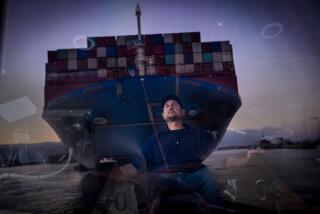Dockworker Strength Test Short, Strenuous, Sweaty
The test that the dockworkers are required to take is broken down into three stages, and takes only minutes to administer. Most applicants, however, leave the testing room wiping a little sweat from their brows.
A 34-year-old reporter, not known for athletic prowess but not considered a wimp either, was allowed to take the test with the restriction that he would not be told how his final score was calculated or how he ranked on the grading scale.
The first part, called the arm lift test, requires the worker to stand erect and keep his elbows at a 90-degree angle. Grasping a bar attached to a chain, the worker is instructed to pull up as hard as he can without bending his arms.
The test lasts three seconds and is repeated three times. Each time a reading is taken from a gauge that measures how many pounds the applicant theoretically is capable of lifting.
The second part of the test is a trickier--and more humbling--experience.
Called the stabilometer test, it determines a dockworker’s ability to balance himself. The test predicts how the applicant would perform if he were required, say, to work atop cargo containers stacked on a ship.
Standing on a platform that is about 3 by 4 feet and has a fulcrum under it, somewhat like a teeter-totter, a worker is given three 30-second attempts to balance himself on the board without the board touching the ground. The applicant’s score is determined by how many seconds during each 30-second interval he was able to keep the board balanced.
The last part of the test is the most grueling. Called an arm endurance test, it requires the worker to kneel in front of a machine that has two bicycle-like pedals.
The machine is adjusted so that the worker, his arms stretched out in front of him and a hand on each pedal, is pushing and pulling 50 pounds of pressure as the pedals move in a complete circle.
The applicant has two minutes to turn the pedals as fast and as many times as he can. The worker’s score is the total number of times he was capable of moving the pedals in complete circles during the allotted time.
After taking the test, the reporter was told he had barely passed the test.
A few fewer turns of the pedals, he was told, and he would have been barred from the waterfront.

